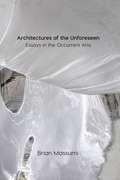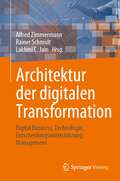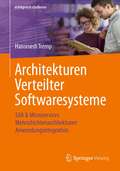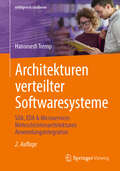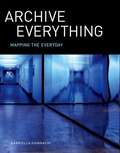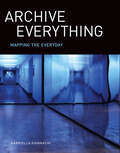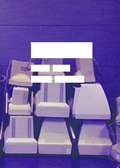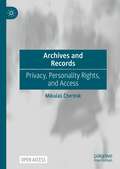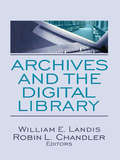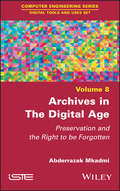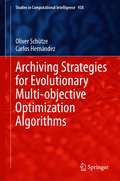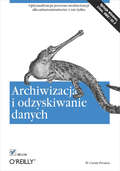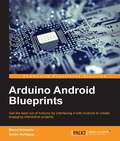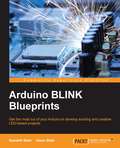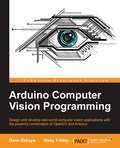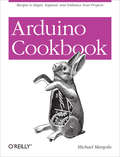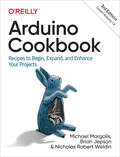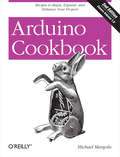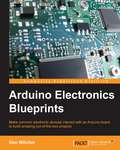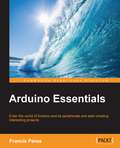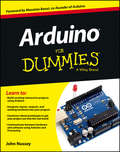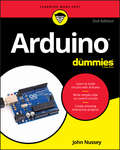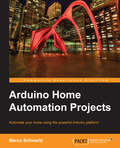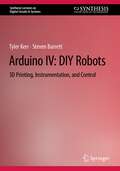- Table View
- List View
Architectures of the Unforeseen: Essays in the Occurrent Arts
by Brian MassumiA beautifully written study of three pioneering artists, entwining their work and our understanding of creativity Bringing the creative process of three contemporary artists into conversation, Architectures of the Unforeseen stages an encounter between philosophy and art and design. Its gorgeous prose invites the reader to think along with Brian Massumi as he thoroughly embodies the work of these artists, walking the line that separates theory from art and providing equally nurturing sustenance for practicing artists and working philosophers.Based on Massumi&’s lengthy—and in two cases decades-long—relationships with digital architect Greg Lynn, interactive media artist Rafael-Lozano Hemmer, and mixed-media installation creator Simryn Gill, Architectures of the Unforeseen delves into their processes of creating art. The book&’s primary interest is in what motivates each artist&’s practice—the generative knots that inspire creativity—and in how their pieces work to give off their unique effects. More than a series of profiles or critical pieces, Massumi&’s essays are creative, developing new philosophical concepts and offering rigorous sentiments about art and creativity.Asking fundamental questions about nature, culture, and the emergence of the new, Architectures of the Unforeseen is important original research on artists that are pioneers in their field. Equally valuable to the everyday reader and those engaged in scholarly work, it is destined to become an important book not only for the fields of digital architecture, interactive media, and installation art, but also more basically for our knowledge of art and creativity.
Architektur der digitalen Transformation: Digital Business, Technologie, Entscheidungsunterstützung, Management
by Lakhmi C. Jain Rainer Schmidt Alfred ZimmermannDieses forschungsorientierte Buch enthält wichtige Beiträge zur Gestaltung der digitalen Transformation. Es umfasst die folgenden Hauptabschnitte in 20 Kapiteln:- Digitale Transformation- Digitales Geschäft- Digitale Architektur- Entscheidungshilfe- Digitale Anwendungen Es konzentriert sich auf digitale Architekturen für intelligente digitale Produkte und Dienstleistungen und ist eine wertvolle Ressource für Forscher, Doktoranden, Postgraduierte, Absolventen, Studenten, Akademiker und Praktiker, die sich für die digitale Transformation interessieren.
Architekturen Verteilter Softwaresysteme: SOA & Microservices - Mehrschichtenarchitekturen - Anwendungsintegration (erfolgreich studieren)
by Hansruedi TrempDas Lehrbuch führt schrittweise in die faszinierende Welt der modernen verteilten Softwaresysteme ein. Dabei beginnt die Reise mit Überlegungen zu den Tätigkeiten des Softwarearchitekten. Weiter geht es zur Modellierung von serviceorientierten Mehrschichtenarchitekturen sowie deren technischer Umsetzung in den einzelnen Schichten. Dabei beschäftigt sich das Buch mit aktuellen Technologien wie z. B. Microservices, SPA, PWA, node.js, .NET, JEE und vieles mehr. Ausführungen zur organisationsinternen sowie -übergreifenden Anwendungsintegration auf der Präsentations-, Applikations- und Datenebene runden die Reise ab. Ein durchgehendes anschauliches Beispiel zur Illustration der theoretischen Ausführungen sowie fallstudienbezogene Aufgaben bieten die Möglichkeit der unmittelbaren Anwendung des Gelernten.
Architekturen verteilter Softwaresysteme: SOA, EDA & Microservices Mehrschichtenarchitekturen Anwendungsintegration (erfolgreich studieren)
by Hansruedi TrempDas Lehrbuch führt schrittweise in die vielfältigen Architekturen moderner verteilter Softwaresysteme ein. Die Reise beginnt mit einer Erörterung des Berufsbilds des Softwarearchitekten und geht mit Darlegungen über die serviceorientierte und ereignisorientierte Architektur weiter. Verschiedene Architekturstile kommen zur Sprache, wie z.B. die Mehrschichtenarchitektur, die hexagonale Architektur und Microservices. Im Kontext der Client-Architekturen wird eine breite Palette von Technologien für Web Apps (wie JSF, Blazor, SPA, PWA) und installierbare Apps (darunter Native, Hybrid, Cross-Platform) dargelegt. Wichtige Technologiestacks wie Scriptbasiert, .NET und Jakarta EE finden eine gebührende Darlegung. Ausführungen zur organisationsinternen sowie -übergreifenden Anwendungsintegration auf der Präsentations-, Applikations- und Datenebene runden die Reise ab. Ein durchgehendes Beispiel und fallstudienbezogene Aufgaben illustrieren die theoretischen Ausführungen und ermöglichen die direkte Anwendung des Erlernten. Die 2. Auflage bietet Aktualisierungen und Erweiterungen und wie z.B. C4-Model, vertiefte Ausführung der ereignisorientierten Architektur, hexagonale Architektur und Blazor.
Archive Everything: Mapping the Everyday
by Gabriella GiannachiIn Archive Everything, Gabriella Giannachi traces the evolution of the archive into the apparatus through which we map the everyday. The archive, traditionally a body of documents or a site for the preservation of documents, changed over the centuries to encompass, often concurrently, a broad but interrelated number of practices not traditionally considered as archival. Archives now consist of not only documents and sites but also artworks, installations, museums, social media platforms, and mediated and mixed reality environments. Giannachi tracks the evolution of these diverse archival practices across the centuries. Archives today offer a multiplicity of viewing platforms to replay the past, capture the present, and map our presence. Giannachi uses archaeological practices to explore all the layers of the archive, analyzing Lynn Hershman Leeson's !Women Art Revolution project, a digital archive of feminist artists. She considers the archive as a memory laboratory, with case studies that include visitors' encounters with archival materials in the Jewish Museum in Berlin. She discusses the importance of participatory archiving, examining the "multimedia roadshow" Digital Diaspora Family Reunion as an example. She explores the use of the archive in works that express the relationship between ourselves and our environment, citing Andy Warhol and Ant Farm, among others. And she looks at the transmission of the archive through the body in performance, bioart, and database artworks, closing with a detailed analysis of Lynn Hershman Leeson's Infinity Engine.
Archive Everything: Mapping the Everyday
by Gabriella GiannachiHow the archive evolved to include new technologies, practices, and media, and how it became the apparatus through which we map the everyday.In Archive Everything, Gabriella Giannachi traces the evolution of the archive into the apparatus through which we map the everyday. The archive, traditionally a body of documents or a site for the preservation of documents, changed over the centuries to encompass, often concurrently, a broad but interrelated number of practices not traditionally considered as archival. Archives now consist of not only documents and sites but also artworks, installations, museums, social media platforms, and mediated and mixed reality environments. Giannachi tracks the evolution of these diverse archival practices across the centuries. Archives today offer a multiplicity of viewing platforms to replay the past, capture the present, and map our presence. Giannachi uses archaeological practices to explore all the layers of the archive, analyzing Lynn Hershman Leeson's !Women Art Revolution project, a digital archive of feminist artists. She considers the archive as a memory laboratory, with case studies that include visitors' encounters with archival materials in the Jewish Museum in Berlin. She discusses the importance of participatory archiving, examining the “multimedia roadshow” Digital Diaspora Family Reunion as an example. She explores the use of the archive in works that express the relationship between ourselves and our environment, citing Andy Warhol and Ant Farm, among others. And she looks at the transmission of the archive through the body in performance, bioart, and database artworks, closing with a detailed analysis of Lynn Hershman Leeson's Infinity Engine.
Archives (In Search of Media)
by Andrew Lison Tomislav Medak Rick Prelinger Marcel MarsHow digital networks and services bring the issues of archives out of the realm of institutions and into the lives of everyday users Archives have become a nexus in the wake of the digital turn. Electronic files, search engines, video sites, and media player libraries make the concepts of &“archival&” and &“retrieval&” practically synonymous with the experience of interconnected computing. Archives today are the center of much attention but few agendas. Can archives inform the redistribution of power and resources when the concept of the public library as an institution makes knowledge and culture accessible to all members of society regardless of social or economic status? This book sets out to show that archives need our active support and continuing engagement. This volume offers three distinct perspectives on the present status of archives that are at once in disagreement and solidarity with each other, from contributors whose backgrounds cut across the theory–practice divide. Is the increasing digital storage of knowledge pushing us toward a turning point in its democratization? Can archives fulfill their paradoxical potential as utopian sites in which the analog and the digital, the past and future, and remembrance and forgetting commingle? Is there a downside to the present-day impulse toward total preservation?
Archives and Records: Privacy, Personality Rights, and Access
by Mikuláš ČtvrtníkThis open access book addresses the protection of privacy and personality rights in public records, records management, historical sources, and archives; and historical and current access to them in a broad international comparative perspective. Considering the question “can archiving pose a security risk to the protection of sensitive data and human rights?”, it analyses data security and presents several significant cases of the misuse of sensitive personal data, such as census data or medical records. It examines archival inflation and the minimisation and reduction of data in public records and archives, including data anonymisation and pseudonymisation, and the risks of deanonymisation and reidentification of persons. The book looks at post-mortem privacy protection, the relationship of the right to know and the right to be forgotten and introduces a specific model of four categories of the right to be forgotten. In its conclusion, the book presents a set of recommendations for archives and records management.
Archives and the Digital Library
by William E. Landis Robin L. ChandlerTechnological advances and innovative perspectives constantly evolve the notion of what makes up a digital library. Archives and the Digital Library provides an insightful snapshot of the current state of archiving in the digital realm. Respected experts in library and information science present the latest research results and illuminating case studies to provide a comprehensive glimpse at the theory, technological advances, and unique approaches to digital information management as it now stands. The book focuses on digitally reformatted surrogates of non-digital textual and graphic materials from archival collections, exploring the roles archivists can play in broadening the scope of digitization efforts through creatively developing policies, procedures, and tools to effectively manage digital content.Many of the important advances in digitization of materials have little to do with the efforts of archivists. Archives and the Digital Library concentrates specifically on the developments in the world of archives and the digitization of the unique content of information resources archivists deal with on a constant basis. This resource reviews the current issues and challenges, effective user assessment techniques, various digital resources projects, collaboration strategies, and helpful best practices. The book is extensively referenced and includes helpful illustrative figures.Topics in Archives and the Digital Library include: a case study of LSTA-grant funded California Local History Digital Resources Project expanding the scope of traditional archival digitations projects beyond the limits of a single institution a case study of the California Cultures Project the top ten themes in usability issues case studies of usability studies, focus groups, interviews, ethnographic studies, and web log analysis developing a reciprocal partnership with a digital library the technical challenges in harvesting and managing Web archives metadata strategies to provide descriptive, technical, and preservation related information about archived Web sites long-term preservation of digital materials building a trusted digital repository collaboration in developing and supporting the technical and organizational infrastructure for sustainability in both academic and state government the Archivists’ Toolkit software applicationArchives and the Digital Library is timely, important reading for archivists, librarians, library administrators, library information educators, archival educators, and students.
Archives in the Digital Age: Preservation and the Right to be Forgotten
by Abderrazak MkadmiArchiving has become an increasingly complex process. The challenge is no longer how to store the data but how to store it intelligently, in order to exploit it over time, while maintaining its integrity and authenticity. Digital technologies bring about major transformations, not only in terms of the types of documents that are transferred to and stored in archives, in the behaviors and practices of the humanities and social sciences (digital humanities), but also in terms of the volume of data and the technological capacity for managing and preserving archives (Big Data). Archives in The Digital Age focuses on the impact of these various digital transformations on archives, and examines how the right to memory and the information of future generations is confronted with the right to be forgotten; a digital prerogative that guarantees individuals their private lives and freedoms.
Archiving Strategies for Evolutionary Multi-objective Optimization Algorithms (Studies in Computational Intelligence #938)
by Carlos Hernández Oliver SchützeThis book presents an overview of archiving strategies developed over the last years by the authors that deal with suitable approximations of the sets of optimal and nearly optimal solutions of multi-objective optimization problems by means of stochastic search algorithms. All presented archivers are analyzed with respect to the approximation qualities of the limit archives that they generate and the upper bounds of the archive sizes. The convergence analysis will be done using a very broad framework that involves all existing stochastic search algorithms and that will only use minimal assumptions on the process to generate new candidate solutions. All of the presented archivers can effortlessly be coupled with any set-based multi-objective search algorithm such as multi-objective evolutionary algorithms, and the resulting hybrid method takes over the convergence properties of the chosen archiver. This book hence targets at all algorithm designers and practitioners in the field of multi-objective optimization.
Archiwizacja i odzyskiwanie danych
by W. Curtis PrestonOptymalizacja procesu archiwizacji dla administratorów i nie tylko Jak archiwizowa? i odtwarza? system oraz dane? Jak wybra? optymaln? metod? archiwizacji? Jak ograniczy? koszty zwi?zane z procesem archiwizacji? Wdro?enie systemu archiwizacji jest podstawow? czynno?ci?, jak? administrator powinien wykona?. Cel tej procedury jest oczywisty, tak jak cena, jak? przyjdzie zap?aci? za brak takiego systemu. Utrata danych lub krach systemu wcale nie musz? oznacza? dla firmy d?ugiego postoju i nara?a? jej na wielkie straty; wtedy to w?a?nie wysi?ek, jaki w?o?y? administrator w system archiwizacji, jest doceniany przez pracodawców i wspó?pracowników. Jakie urz?dzenia i narz?dzia nale?y zastosowa?, aby ten proces by? sprawny i szybki, a jednocze?nie zmie?ci? si? w wyznaczonym do tego celu bud?ecie? Opisane oprogramowanie i rady udzielone przez autora tej ksi??ki pomog? Ci dokona? w?a?ciwego wyboru. "Archiwizacja i odzyskiwanie danych" to przewodnik po darmowych narz?dziach do archiwizacji i odzyskiwania danych, przeznaczony g?ównie dla administratorów. W. Curtis Preston, specjalista w dziedzinie ochrony danych, zwróci? uwag?, ?e ?rodki przeznaczone na system archiwizacji s? cz?sto zbyt ma?e, by zapewni? mu wysok? skuteczno??. Przygl?daj?c si? bli?ej bezp?atnym narz?dziom, odkry? ich du?e mo?liwo?ci; swoje spostrze?enia i uwagi na ich temat zapisa? w tej ksi??ce. Pr?dzej czy pó?niej ka?dy administrator staje przed konieczno?ci? odbudowania systemu lub odzyskania danych i w?a?nie lektura tej ksi??ki sprawi, ?e b?dzie na to przygotowany! Narz?dzia do archiwizacji i odtwarzania danych Przegl?d programów komercyjnych i darmowych Urz?dzenia archiwizuj?ce Przywracanie komputera od podstaw z wybranym systemem operacyjnym Archiwizacja i odtwarzanie baz danych Sposoby zabezpieczania archiwum i magazynów danych Wykorzystanie wirtualnych maszyn w procesie archiwizacji Poszerz swoj? wiedz? i archiwizuj dane we w?a?ciwy, a tak?e sprawdzony sposób!
Arduino Android Blueprints
by Marco Schwartz Stefan ButtigiegThis book is for those who want to learn how to build exciting Arduino projects by interfacing it with Android. You will need to have some basic experience in electronics and programming. However, you don't need to have any previous experience with the Arduino or Android platforms.
Arduino BLINK Blueprints
by Samarth Shah Utsav ShahAnyone with a basic computer knowledge should be able to get the most out of this book. Although familiarity with some of the electronics would be helpful, it is not a must.
Arduino Computer Vision Programming
by Giray Yillikci Özen ÖzkayaIf you are a consumer and hobbyist who has familiarity with the basics of Arduino and wish to learn computer vision programming with Arduino to create intelligent systems, then this book is for you. No knowledge of computer vision programming is required.
Arduino Cookbook (Oreilly And Associate Ser.)
by Michael MargolisCreate your own toys, remote controllers, alarms, detectors, robots, and many other projects with the Arduino device. This simple microcontroller board lets artists and designers build a variety of amazing objects and prototypes that interact with the physical world. With this cookbook you can dive right in and experiment with more than a hundred tips and techniques, no matter what your skill level is.The recipes in this book provide solutions for most common problems and questions Arduino users have, including everything from programming fundamentals to working with sensors, motors, lights, and sound, or communicating over wired and wireless networks. You'll find the examples and advice you need to begin, expand, and enhance your projects right away.Get to know the Arduino development environmentUnderstand the core elements of the Arduino programming languageUse common output devices for light, motion, and soundInteract with almost any device that has a remote controlLearn techniques for handling time delays and time measurementUse simple ways to transfer digital information from sensors to the Arduino deviceCreate complex projects that incorporate shields and external modulesUse and modify existing Arduino libraries, and learn how to create your own
Arduino Cookbook: Recipes to Begin, Expand, and Enhance Your Projects (Oreilly And Associate Ser.)
by Brian Jepson Michael Margolis Nicholas Robert WeldinWant to create devices that interact with the physical world? This cookbook is perfect for anyone who wants to experiment with the popular Arduino microcontroller and programming environment. You’ll find more than 200 tips and techniques for building a variety of objects and prototypes such as IoT solutions, environmental monitors, location and position-aware systems, and products that can respond to touch, sound, heat, and light.Updated for the Arduino 1.8 release, the recipes in this third edition include practical examples and guidance to help you begin, expand, and enhance your projects right away—whether you’re an engineer, designer, artist, student, or hobbyist.Get up to speed on the Arduino board and essential software concepts quicklyLearn basic techniques for reading digital and analog signalsUse Arduino with a variety of popular input devices and sensorsDrive visual displays, generate sound, and control several types of motorsConnect Arduino to wired and wireless networksLearn techniques for handling time delays and time measurementApply advanced coding and memory-handling techniques
Arduino Cookbook: Recipes to Begin, Expand, and Enhance Your Projects (Oreilly And Associate Ser.)
by Michael MargolisWant to create devices that interact with the physical world? This cookbook is perfect for anyone who wants to experiment with the popular Arduino microcontroller and programming environment. You'll find more than 200 tips and techniques for building a variety of objects and prototypes such as toys, detectors, robots, and interactive clothing that can sense and respond to touch, sound, position, heat, and light. You don't need experience with Arduino or programming to get started. Updated for the Arduino 1.0 release, the recipes in this second edition include practical examples and guidance to help you begin, expand, and enhance your projects right away--whether you're an artist, designer, hobbyist, student, or engineer. Get up to speed on the Arduino board and essential software concepts quickly Learn basic techniques for reading digital and analog signals Use Arduino with a variety of popular input devices and sensors Drive visual displays, generate sound, and control several types of motors Interact with devices that use remote controls, including TVs and appliances Learn techniques for handling time delays and time measurement Apply advanced coding and memory handling techniques
Arduino Development Cookbook
by Cornel AmarieiIf you want to build programming and electronics projects that interact with the environment, this book will offer you dozens of recipes to guide you through all the major applications of the Arduino platform. It is intended for programming or electronics enthusiasts who want to combine the best of both worlds to build interactive projects.
Arduino Electronics Blueprints
by Don WilcherThis book is intended for those who want to learn about electronics and coding by building amazing devices and gadgets with Arduino. If you are an experienced developer who understands the basics of electronics, then you can quickly learn how to build smart devices using Arduino. The only experience needed is a desire to learn about electronics, circuit breadboarding, and coding.
Arduino Essentials
by Francis PereaIf you are a hobbyist who wants to develop projects based on Arduino as the main microcontroller platform or an engineer interested in finding out what the Arduino platform offers, then this book is ideal for you. Some prior knowledge of the C programming language is required.
Arduino For Dummies
by John NusseyThe quick, easy way to leap into the fascinating world of physical computingThis is no ordinary circuit board. Arduino allows anyone, whether you're an artist, designer, programmer or hobbyist, to learn about and play with electronics. Through this book you learn how to build a variety of circuits that can sense or control things in the real world. Maybe you'll prototype your own product or create a piece of interactive artwork? This book equips you with everything you'll need to build your own Arduino project, but what you make is up to you! If you're ready to bring your ideas into the real world or are curious about the possibilities, this book is for you.?? Learn by doing ? start building circuits and programming your Arduino with a few easy to follow examples - right away!? Easy does it ? work through Arduino sketches line by line in plain English, to learn of how a they work and how to write your own? Solder on! ? Only ever used a breadboard in the kitchen? Don't know your soldering iron from a curling iron? No problem, you'll be prototyping in no time? Kitted out ? discover new and interesting hardware to make your Arduino into anything from a mobile phone to a geiger counter!? Become an Arduino savant ? learn all about functions, arrays, libraries, shields and other tools of the trade to take your Arduino project to the next level.? Get social ? teach your Arduino to communicate with software running on a computer to link the physical world with the virtual worldIt's hardware, it's software, it's fun! Start building the next cool gizmo with Arduino and Arduino For Dummies.
Arduino For Dummies
by John NusseyBring your ideas to life with the latest Arduino hardware and software Arduino is an affordable and readily available hardware development platform based around an open source, programmable circuit board. You can combine this programmable chip with a variety of sensors and actuators to sense your environment around you and control lights, motors, and sound. This flexible and easy-to-use combination of hardware and software can be used to create interactive robots, product prototypes and electronic artwork, whether you’re an artist, designer or tinkerer. Arduino For Dummies is a great place to start if you want to find out about Arduino and make the most of its incredible capabilities. It helps you become familiar with Arduino and what it involves, and offers inspiration for completing new and exciting projects. • Covers the latest software and hardware currently on the market • Includes updated examples and circuit board diagrams in addition to new resource chapters • Offers simple examples to teach fundamentals needed to move onto more advanced topics • Helps you grasp what’s possible with this fantastic little board Whether you’re a teacher, student, programmer, hobbyist, hacker, engineer, designer, or scientist, get ready to learn the latest this new technology has to offer!
Arduino Home Automation Projects
by Marco SchwartzThis book is divided into projects that are explained in a step-by-step format, with practical instructions that are easy to follow. If you want to build your own home automation systems wirelessly using the Arduino platform, this is the book for you. You will need to have some basic experience in Arduino and general programming languages, such as C and C++ to understand the projects in this book.
Arduino IV: 3D Printing, Instrumentation, and Control (Synthesis Lectures on Digital Circuits & Systems)
by Steven Barrett Tyler KerrThis book gives a step-by-step introduction to designing and building your own robots. As with other books in the Arduino series, the book begins with a quick overview of the Arduino Integrated Development Environment (IDE) used to write sketches, and the hardware systems aboard the Arduino UNO R3 and the Mega 2560 Rev 3. The level of the text makes it accessible for students, hobbyist and professionals' first introduction to both Arduino and Robotics. This book will be accessible by all levels of students, advanced hobbyists and engineering professionals, whether using as a self-reference or within a structure design laboratory. The text then examines the many concepts and characteristics common to all robots. In addition, throughout the book , reasonably priced, easily accessible and available off-the-shelf robots are examined. Examples include wheeled robots, tracked robots and also a robotic arm. After a thorough and easy to follow Arduino IDE and hardware introduction, the book launches into “do it yourself” or DIY concepts. A unique feature of the book is to start with a hands-on introduction to low cost 3D printing. These concepts will allow you to design and print your own custom robot parts and chassis. We then explore concepts to sense a robot's environment, move the robot about and provide a portable power source. We conclude with a several DIY robot projects.
